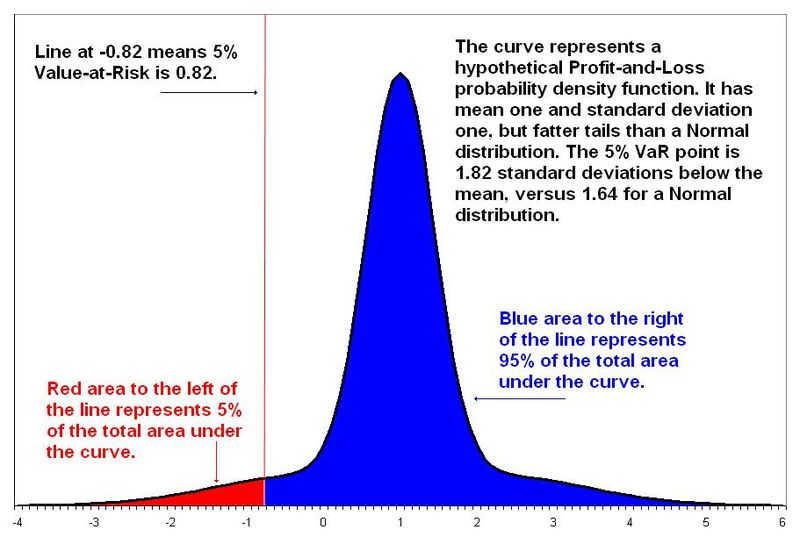Value at Risk (VaR) is a popular risk management technique used by traders to estimate the maximum loss that can occur in a given time period with a certain level of confidence. In other words, it provides a measure of the potential downside risk of a portfolio or individual asset. To calculate VaR, traders use a mathematical model that takes into account various factors such as historical prices, volatility, and correlations. One popular method of implementing VaR models is through programming languages such as Python. Python is a versatile and popular programming language among traders due to its ease of use and ability to handle large datasets. With Python, traders can quickly develop and test VaR models, making it an essential tool for risk management. In this article, we will explore the concept of VaR and how it can be implemented using Python. We will discuss the different VaR models available, their strengths and weaknesses, and how to code them in Python. We will also provide examples of how VaR models can be used in real-world trading scenarios. Whether you’re a seasoned trader or just starting, understanding the value at risk model in Python is crucial for managing risk and maximizing returns. So, let’s dive into the world of VaR and Python programming.
How To Calculate VaR?
Value at Risk (VaR) is a statistical measure that estimates the potential maximum loss of an investment portfolio over a specific period of time, with a certain level of confidence. VaR is typically calculated using historical data and probability distributions to forecast potential losses.
To calculate VaR, there are three primary components that need to be determined: the time horizon, the confidence level, and the volatility of the portfolio. The time horizon is the length of time over which the VaR calculation will be made. The confidence level is the degree of certainty that the estimated maximum loss will not be exceeded within the given time horizon. The volatility of the portfolio is the degree to which the value of the portfolio fluctuates over time.
There are various methods to calculate Value at Risk (VaR), which is a statistical technique used to estimate the potential loss of an investment portfolio at a certain confidence level within a specified time horizon. Here are three different models used to calculate VaR:
- Historical Simulation Model: This model uses historical data to simulate the potential outcomes of a portfolio. It involves collecting historical returns for a given period and sorting them from the worst to the best returns. Then, the VaR is calculated based on the worst returns that fall within a certain confidence level. The historical simulation model does not rely on any assumptions about the distribution of returns.
- Variance-Covariance Model: This is a widely used method for calculating VaR, and it is based on the assumption that stock returns follow a normal distribution. The model uses the variance-covariance matrix of the stock returns to estimate the potential loss of a portfolio. The VaR is calculated by multiplying the standard deviation of the portfolio by a given confidence level and the value of the portfolio.
- Monte Carlo Simulation Model: This is a complex method used to simulate thousands of potential outcomes for a portfolio. It involves generating random values for future returns, which are then used to calculate the potential losses of the portfolio. This model does not rely on any assumptions about the distribution of returns and provides a more accurate estimate of VaR than the other models.
Methods related to (2) assume that the PnL is a probability density function looking like:

In summary, the variance-covariance model assumes normal distribution of stock returns, the historical simulation model relies on historical data to simulate potential outcomes, while the Monte Carlo simulation model generates thousands of random values to calculate the potential losses of a portfolio. Each model has its strengths and weaknesses, and traders and investors should carefully consider which model is best suited for their specific investment goals and risk management strategies.
Python Snippets To Calculate VaR
Here we give 2 different ways to calculate VaR using the historical approach and the variance-covariance model.
This code uses the yfinance library to download 1-year of historical data for Apple stock. It then calculates daily returns and log returns, and uses the log returns to calculate the volatility. The np.quantile() function is used to calculate the estimated maximum loss at the given confidence level, and the VaR is calculated using the formula VaR = -1 * sqrt(time_horizon) * volatility * quantile.
import numpy as np
import pandas as pd
import yfinance as yf
# Get Apple stock data for 1 year
apple_data = yf.download('AAPL', start='2022-04-06', end='2023-04-06')
# Calculate daily returns
apple_data['returns'] = apple_data['Adj Close'].pct_change()
# Calculate daily log returns
apple_data['log_returns'] = np.log(1 + apple_data['returns'])
# Calculate volatility
volatility = apple_data['log_returns'].std()
# Set confidence level
confidence_level = 0.95
# Set time horizon
time_horizon = 1 # year
# Calculate VaR
VaR = -1 * np.sqrt(time_horizon) * volatility * np.quantile(apple_data['log_returns'], confidence_level)
print('The 1-year VaR for Apple stock at a confidence level of', confidence_level, 'is', round(VaR, 2))
This code uses the yfinance library to download 1-year of historical data for Apple stock. It then calculates daily returns and log returns, and uses the log returns to calculate the volatility. The np.quantile() function is used to calculate the estimated maximum loss at the given confidence level, and the VaR is calculated using the formula VaR = -1 * sqrt(time_horizon) * volatility * quantile. Note that this is just one example of how VaR can be calculated in Python, and there are many other methods and libraries available.
But here is another code that uses the yfinance library to download 1-year of historical data for Apple stock. It then calculates daily returns and log returns, and uses the log returns to calculate the variance-covariance matrix. The inverse_normal variable calculates the inverse of the normal distribution function. Finally, the VaR is calculated using the formula VaR = -1 * sqrt(time_horizon) * inverse_normal * sqrt(cov_matrix * current_price) * sqrt(-log(confidence_level)). Value at Risk model, Python:
import numpy as np
import pandas as pd
import yfinance as yf
# Get Apple stock data for 1 year
apple_data = yf.download('AAPL', start='2022-04-06', end='2023-04-06')
# Calculate daily returns
apple_data['returns'] = apple_data['Adj Close'].pct_change()
# Calculate daily log returns
apple_data['log_returns'] = np.log(1 + apple_data['returns'])
# Calculate the variance-covariance matrix
cov_matrix = np.cov(apple_data['log_returns'], rowvar=False)
# Set confidence level
confidence_level = 0.95
# Set time horizon
time_horizon = 1 # year
# Calculate the inverse of the normal distribution function
inverse_normal = np.abs(np.linalg.inv(np.random.normal(size=(len(cov_matrix), len(cov_matrix)))))[0]
# Calculate VaR
VaR = -1 * np.sqrt(time_horizon) * np.dot(np.dot(inverse_normal, cov_matrix), inverse_normal) * np.sqrt(np.dot(np.dot(apple_data['log_returns'].tail(1), cov_matrix), apple_data['log_returns'].tail(1).T)) * np.sqrt(-np.log(confidence_level))
print('The 1-year VaR for Apple stock at a confidence level of', confidence_level, 'is', round(VaR, 2))Conclusion
Value at Risk (VaR) is an important risk management tool used by traders and investors to estimate the maximum potential loss of a portfolio or investment. There are different ways to calculate VaR, including the variance-covariance approach, historical simulation, and Monte Carlo simulation.
Python can be very useful for calculating VaR because it provides powerful data analysis libraries such as NumPy, Pandas, and Scikit-learn, which can be used to perform the necessary calculations quickly and efficiently. Additionally, there are libraries like yfinance and AlphaVantage that allow for easy access to historical stock price data, which is necessary for calculating VaR. “value at risk model python” is searched a lot!
The variance-covariance approach is one of the most widely used methods for calculating VaR, and it can be easily implemented in Python using the NumPy library. Historical simulation, which involves using historical returns to simulate possible future scenarios, can also be implemented in Python using Pandas. Finally, Monte Carlo simulation can be used to estimate VaR, and Python provides the necessary libraries such as Scikit-learn for this approach.
In conclusion, Python is a powerful tool for calculating VaR using various methods, and it can help traders and investors make informed decisions about risk management. By leveraging Python’s data analysis libraries and powerful financial data access libraries, traders can quickly and easily calculate VaR to assess risk in their portfolios.
n.b: this is not financial advice

